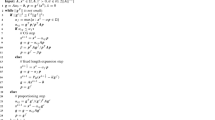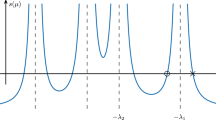Abstract
An algorithm for computing a stationary point of a quadratic program with box constraints(BQP) is proposed. Each iteration of this procedure comprises a guessing strategy whichforecasts the active bounds at a stationary point, the determination of a descent direction bymeans of solving a reduced strictly convex quadratic program with box constraints and anexact line search. Global convergence is established in the sense that every accumulationpoint is stationary. Moreover, it is shown that the algorithm terminates after a finite numberof iterations, if at least one iterate is sufficiently close to a stationary point which satisfiesa certain sufficient optimality condition. The algorithm can be easily implemented for sparselarge-scale BQPs. Furthermore, it simplifies for concave BQPs, as it is not required to solvestrictly convex quadratic programs in this case. Computational experience with large-scaleBQPs is included and shows the appropriateness of this type of methodology.
Similar content being viewed by others
References
D.P. Bertsekas, Constrained Optimization and Lagrange Multipliers Methods, Academic Press, New York, 1982.
E.M. Bomze and G. Danninger, A finite algorithm for solving general quadratic problems, Journal of Global Optimization 4(1994)1–16.
T. Coleman and L. Hulbert, A direct active set algorithm for large sparse quadratic programs with bounds, Mathematical Programming 45(1989)373–406.
T. Coleman and Y. Li, A reflective Newton method for minimizing a quadratic function subject to bounds on some of the variables, Technical Report TR 92-1315, Department of Computer Science, Cornell University, USA, 1992.
A. Conn, N. Gould and Ph. Toint, Global convergence of a class of trust regions algorithm for optimization with simple bounds, SIAM Journal on Numerical Analysis 25(1988)433–460.
I. Bongartz, A. Conn, N. Gould and Ph. Toint, CUTE: Constrained and unconstrained testing environment, Technical Report 93/10, Department of Mathematics, Faculté Universitaires ND de la Paix, Namur, Belgium, 1993.
J.W. Daniel, Stability of the solution of definite quadratic programs, Mathematical Programming 5(1973)41–53.
R. Dembo and U. Tulowitzski, On the minimization of quadratic functions subject to box constraints, Technical Report, Department of Computer Science, Yale University, USA, 1983.
I.S. Duff, R.G. Grimes and J.G. Lewis, Sparse matrix test problems, ACM Transactions on Mathematical Software 15(1989)1–14.
A. Faustino and J. JÚdice, Minimization of a concave quadratic function subject to box constraints, Investigacion Operativa 4(1994)49–68.
A. Faustino and J. JÚdice, Principal pivoting algorithms for a concave generalized linear complementarity problem, Investigação Operacional 14(1994)133–146.
L. Fernandes, J. JÚdice and J. Patricio, An investigation of the interior-point and block pivoting algorithms for large-scale symmetric monotone linear complementarity problems, Computational Optimization and Applications 5(1996)49–77.
R. Fletcher and M. Jackson, Minimization of a quadratic function subject only to upper and lower bounds, Journal of Mathematics and Applications 14(1974)159–174.
P. Hansen, B. Jaumard, M. Ruiz and J. Xiong, Global minimization of indefinite quadratic functions subject to box constraints, Naval Research Logistics 40(1993)373–392.
J. JÚdice and M. Pires, Direct methods for convex quadratic programs subject to box constraints, Investigaão Operacional 9(1989)23–56.
J. JÚdice and F. Pires, A block principal pivoting algorithm for large-scale strictly monotone linear complementarity problems, Computers and Operations Research 21(1994)587–596.
A. Conn, N. Gould and Ph. Toint, LANCELOT–A Fortran Package for Large-Scale Nonlinear Optimization, Springer, 1992.
J. Moré and G. Toraldo, Algorithms for bound constrained quadratic programming problems, Numerische Mathematik 55(1989)377–400.
K. Murty, Linear Complementarity, Linear and Nonlinear Programming, Heldermann, Berlin, 1988.
P.M. Pardalos and G.P. Rodgers, A branch-and-bound algorithm for the maximum clique problem, Computers and Operations Research 19(1992)363–375.
J. Soares, J. JÚdice, and F. Facchinei, An active set Newton method for large-scale nonlinear programs with box constraints, to appear in SIAM Journal on Optimization.
Rights and permissions
About this article
Cite this article
Fernandes, L., Fischer, A., Júdice, J. et al. A block active set algorithm for large-scalequadratic programming with box constraints. Annals of Operations Research 81, 75–96 (1998). https://doi.org/10.1023/A:1018990014974
Issue Date:
DOI: https://doi.org/10.1023/A:1018990014974




